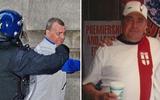
2010-07-22
G20 riot officer filmed striking down newspaper seller will not face charges because of postmortem conflicts, CPS rules
The police officer caught on video during last year’s G20 protests striking a man who later died will not face criminal charges, the Crown Prosecution Service announced today.
Keir Starmer, the director of public prosecutions, said there was “no realistic prospect” of a conviction, because of a conflict between the postmortems carried out after Tomlinson’s death last year.
The newspaper seller died following the demonstrations on 1 April 2009 in central London. The official account that he died from a heart attack was undermined when the Guardian obtained video footage showing a riot officer striking the 47-year-old with a baton and shoving him to the ground shortly before he collapsed and died.
In a written statement the CPS admitted that there was sufficient evidence to show the officer had assaulted Tomlinson, but claimed a host of technical reasons meant he could not be charged.

Tomlinson’s son Paul, flanked by his mother, Julia, who was struggling to hold back tears, said: “It’s been a huge cover-up and they’re incompetent.”
The family, who went to the headquarters of the CPS in London to be told of the decision today, had wanted a charge of manslaughter to be brought against the officer, who was named in media reports as PC Simon Harwood.
In a detailed letter setting out its reasons, the CPS said that the actions of the officer – seen striking Tomlinson with a baton then shoving him to the ground in the footage – amounted to assault.
It said: “The CPS concluded that there is sufficient evidence to provide a reasonable prospect of proving that the actions of PC ‘A’ in striking Mr Tomlinson with his baton and then pushing him over constituted an assault. At the time of those acts Mr Tomlinson did not pose a threat … There is sufficient evidence to provide a realistic prospect of proving that his actions were disproportionate and unjustified.”
But the CPS went on to explain the obstacles to a prosecution posed by the subsequent postmortems.
The first police account that he died from a heart attack was confirmed by a pathologist, Freddy Patel, in the initial postmortem.
But a second postmortem, conducted on behalf of the Independent Police Complaints Commission (IPCC), found Tomlinson died from internal bleeding.
The CPS said it could not bring a manslaughter charge because the conflicting medical evidence meant prosecutors “would simply not be able to prove beyond reasonable doubt that there was a causal link between Mr Tomlinson’s death and the alleged assault on him”.
It said it could not bring a charge for criminal assault because too much time had elapsed: a charge must be brought within six months.
The CPS also ruled out bringing charges of actual bodily harm, and misconduct in public office.
Tomlinson had his hands in his pockets and his back to the officer when he was hit. The video footage suggests that no other police officer went to his aid and it was left to a bystander to lift him to his feet. He appeared to stumble about 100 metres down Cornhill, clutching his side, before collapsing a second time.
Police initially led Tomlinson’s wife and nine children to believe he died of a heart attack after being caught up in the demonstration. In statements to the press, police claimed attempts by officers to save his life by resuscitation were impeded by protesters.
The CPS announcement comes five years to the day since another landmark incident involving police use of force. On 22 July 2005, officers shot dead Jean Charles de Menezes after mistaking him for a terrorist who was about to detonate a bomb. Then, the family of the innocent Brazilian criticised the CPS for failing to bring criminal charges against any individual.
The Tomlinson family had criticised the time it took the CPS to reach their decision.
The first investigation was conducted by the IPCC. Its officials are understood to have reached a clear view as to whether enough evidence existed to support criminal charges.
They were able to complete their inquiries in just four months and submitted a file to the CPS by August.
Key to the investigation were hundreds of hours of footage and thousands of images shot by bystanders at the protest, which enabled them to piece together Tomlinson’s last 30 minutes alive.
CPS officials had assured the family they would decide on whether to prosecute the officer – and on what charge – by Christmas 2009.
The CPS has given various explanations for the delays, and claims it has had to return to the IPCC for clarification several times on different issues.
It is also understood that there have been complications surrounding the evidence of an expert witness.
The IPCC itself was late in mounting an inquiry, claiming there was nothing suspicious about the death for almost a week until the release of footage of the incident obtained by the Guardian forced a U-turn.